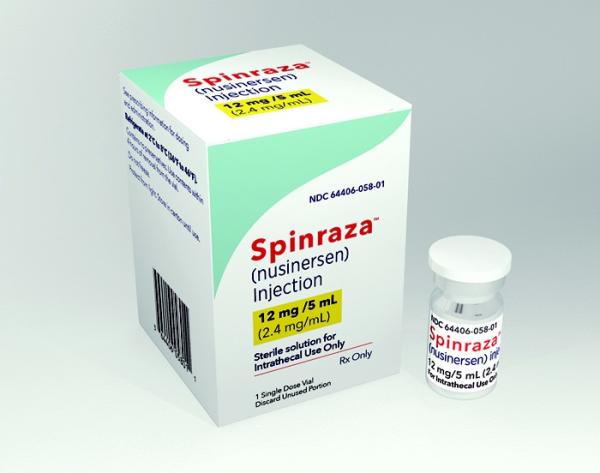Nusinersen Side Effects
Applies to nusinersen: intrathecal solution.
Serious side effects of Nusinersen
Along with its needed effects, nusinersen may cause some unwanted effects. Although not all of these side effects may occur, if they do occur they may need medical attention.
Check with your doctor or nurse immediately if any of the following side effects occur while taking nusinersen:
More common
- Agitation
- black, tarry stools
- bleeding gums
- blood in the urine or stools
- body aches or pain
- chills
- coma
- confusion
- cough
- decreased urine output
- depression
- difficulty with breathing
- dizziness
- ear congestion
- fever
- headache
- irritability
- lethargy
- loss of voice
- muscle twitching
- nausea
- pinpoint red spots on the skin
- rapid weight gain
- runny or stuffy nose
- seizures
- sneezing
- sore throat
- stupor
- swelling of the face, ankles, or hands
- unusual bleeding or bruising
- unusual tiredness or weakness
Other side effects of Nusinersen
Some side effects of nusinersen may occur that usually do not need medical attention. These side effects may go away during treatment as your body adjusts to the medicine. Also, your health care professional may be able to tell you about ways to prevent or reduce some of these side effects.
Check with your health care professional if any of the following side effects continue or are bothersome or if you have any questions about them:
More common
- Back pain
- difficulty having a bowel movement (stool)
- teething
Less common
- Change in hearing
- ear drainage
- earache or pain in the ear
For Healthcare Professionals
Applies to nusinersen: intrathecal solution.
General
The most commonly occurring adverse reactions have included lower respiratory infection and constipation in patients with infantile-onset SMA; pyrexia, headache, vomiting, and back pain in patients with later onset SMA.
Respiratory
Lower respiratory tract infection was the most common adverse reaction occurring in 55% of drug treated patients compared to 37% of those receiving sham. At baseline, patients receiving drug had a higher percentage of paradoxical breathing (89% vs 66%), pneumonia or respiratory symptoms (35% vs 22%) swallowing or feeding difficulties (51% vs 29%), and need for respiratory support (26% vs 15%). Lower respiratory infection includes adenovirus infection, bronchiolitis, bronchitis, viral bronchitis, corona virus infection, Influenza, lower respiratory tract infection, lower respiratory tract infection viral, lung infection, parainfluenzae virus infection, pneumonia, pneumonia bacterial, pneumonia influenza, pneumonia Moraxella, pneumonia parainfluenzae viral, pneumonia pneumococcal, pneumonia pseudomonal, pneumonia respiratory syncytial viral, pneumonia viral, and respiratory syncytial virus bronchiolitis[Ref]
Very common (10% or more): Lower respiratory infection (55%)
Common (1% to 10%): Upper respiratory congestion, epistaxis, respiratory tract congestion[Ref]
Renal
Very common (10% or more): Elevated urinary protein (58%)[Ref]
In sham-controlled studies, 58% (71/123) of patients with infantile-onset and later-onset SMA receiving drug had elevated urine protein compared with 34% (22/65) of those receiving sham.[Ref]
Nervous system
Communicating hydrocephalus not related to meninigitis or bleeding has been reported; some patients have been managed with implantation of ventriculo-peritoneal shunt (VPS). Five cases have been reported to manufacturer as of July 2018.[Ref]
Very common (10% or more): Headache (29%)
Frequency not reported: Post-lumbar puncture syndrome
Postmarketing reports: Meningitis, hydrocephalus, communicating hydrocephalus[Ref]
Musculoskeletal
Very common (10% or more): Back pain (25%)
Frequency not reported: Growth reduction[Ref]
In a controlled study in infants, a reduction in growth of infants was observed; it is unknown if this would be reversible with cessation of treatment.[Ref]
Hematologic
Very common (10% or more): Platelet levels below the lower limit of normal (16%)[Ref]
In sham-controlled studies in patients with infantile-onset and later-onset SMA, 16% (24/146) of patients receiving drug developed a platelet level below the lower limit of normal, compared to 14% (10/72) of those receiving sham. Platelet levels at baseline were high, normal, or unknown. Among patients with later-onset SMA, 2 drug treated patients developed platelet counts less than 50,000 cells/microliter; the lowest level was 10,000 cells/microliter recorded on study day 28.[Ref]
Other
Very common (10% or more): Pyrexia (43%)
Common (1% to 10%): Ear infection, fall[Ref]
Dermatologic
Rash has been reported in 2 patients. The first patient developed painless, red macular lesions on the forearm, leg, and foot over an 8-week period after being on the drug for 8 months. Over 4 weeks, the lesions ulcerated and scabbed over, and resolved over several months. In the second patient, red macular skin lesions developed on the cheek and hand after receiving the drug for 10 months. They resolved over 3 months. Both patients continued to receive the drug.[Ref]
Frequency not reported: Rash[Ref]
Metabolic
Severe hyponatremia requiring salt supplementation for 14 months was reported in an infant with symptomatic SMA.[Ref]
Common (1% to 10%): Decreased weight
Frequency not reported: Hyponatremia[Ref]
Gastrointestinal
Very common (10% or more): Constipation (35%), vomiting (29%)
Common (1% to 10%): Flatulence[Ref]
Immunologic
Common (1% to 10%): Anti-drug antibodies
More about nusinersen
- Check interactions
- Compare alternatives
- Dosage information
- During pregnancy
- Drug class: miscellaneous uncategorized agents
- En español
Patient resources
Other brands
Professional resources
Other brands
Related treatment guides
References
1. Product Information. Spinraza (nusinersen). Biogen Idec Inc. 2017.
Further information
Always consult your healthcare provider to ensure the information displayed on this page applies to your personal circumstances.
Some side effects may not be reported. You may report them to the FDA.

